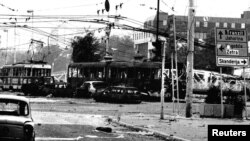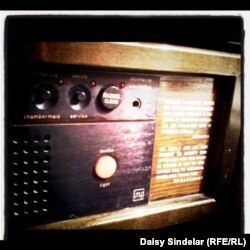SARAJEVO – Between them, the journalists gathering this week in the Bosnian capital for the 20th anniversary of the start of the siege have covered dozens of conflicts: Afghanistan. Beirut. Chechnya. Iraq.
But amid the drinks and chatter of a correspondents’ reunion at the city’s Holiday Inn -- which served as the main base for foreign journalists covering the war -- it soon becomes clear that there is only one Sarajevo. It’s a war that schooled an entire generation of reporters on the best and worst that humanity had to offer, the power of laughter over tears -- and ultimately, the fact that there is only so much journalists can do to change history.
“We were reporting, reporting, reporting. And it took so long for anyone to react,” says Emma Daly, who covered the 44-month siege for Britain’s “Independent” and who now works as communications director for Human Rights Watch. “It was very frustrating. We said at the time that the best we could hope for is that [former British Prime Minister] John Major would never be able to claim later on that he didn’t know what was happening.”
“I remember going back to London and people asking me, ‘What’s it like being shot at?’ says Janine di Giovanni, the American-born journalist and renowned foreign correspondent, who covered the siege for Britain’s “Sunday Times” and describes Sarajevo as her most wrenching assignment. “That was the best they could do. Bosnia simply had no strategic value -- no oil, nothing of use.”
Remy Ourdan, the long-standing war correspondent for France’s “Le Monde,” recalls spending much of the war struggling to tame his retelling of the horrors he was experiencing.
“I covered a bombing of a school. Sometimes the mortar fire was just random, landing here and there, but this was targeted,” he says. “They knew they were firing at a school. There was a child whose head had been split in two. You could see his brains splattered on the chalkboard. I was so angry -- I wrote a very angry piece. When I filed it” – Ourdan was a freelance radio reporter at the time -- “the producer fainted, listening to me. And my editor rejected it.”
Since then, Ourdan -- who has gone on to report from Rwanda, Congo, and Afghanistan, among other places -- says he tries to keep his language “quiet,” although occasionally the old anger slips out.
“Who notices how many people are dying in Afghanistan?” he says. “Sometimes you have to get personal. You can’t do it every day, but sometimes you have to tell what war is about.”
'I Was Really Moved'
Several of the journalists had earlier made their way downtown to attend the day’s anniversary commemorations and to take in the silent row of empty red chairs stretching down the length of the city’s Marshal Tito Street to represent the 11,541 people killed in the siege. Some correspondents confess to having doubts about the chair project, which had become the fodder for teasing by the local media, not least because they came from Serbia.
“I really thought it would be over the top. I wasn’t even planning to go,” says one Bosnian journalist, who spent his war years as a correspondent with the city’s legendary Radio Zid. “But then I came down, and I was really moved. I thought about the people I lost -- my father, my uncle. I was worried that I would run into someone I knew, because I literally didn’t think I’d be able to speak.”
“Nobody shed a tear during the war,” says Sabina Cosic, who was a 22-year-old Sarajevan with better-than-average English when she was brought in as a fixer for Reuters, and whose eventual partner, war correspondent Kurt Schork, was later killed in Sierra Leone. “This week, we’ve been weeping uncontrollably.”
And laughing as well. Many of the correspondents say they savored their time in Bosnia for the black humor that sustained many of the locals. “You know what they say, if you didn’t laugh you would never stop crying,” says Daly. “But they are also extremely funny people.”
Alison Smale, the executive editor of the “International Herald Tribune,” who coordinated coverage of the war for The Associated Press, repeats one particularly grim joke passed on by a local at the worst of the siege’s privations.
Ourdan, who spearheaded efforts to organize what one journalist called the week’s “Sarajevo high-school reunion,” says the Bosnian war will always be different from other conflicts because, both geographically and spiritually, it was a “war at home.”
“I don’t like to say that, but it’s true. When the war started, I drove here in my car,” he says. “These were people with the same books on their bookshelves that I had on mine. The only difference was, they had to burn their books to stay warm.”
“Bosnians are always special,” he says. “But during the war they were extraordinary.”
But amid the drinks and chatter of a correspondents’ reunion at the city’s Holiday Inn -- which served as the main base for foreign journalists covering the war -- it soon becomes clear that there is only one Sarajevo. It’s a war that schooled an entire generation of reporters on the best and worst that humanity had to offer, the power of laughter over tears -- and ultimately, the fact that there is only so much journalists can do to change history.
“We were reporting, reporting, reporting. And it took so long for anyone to react,” says Emma Daly, who covered the 44-month siege for Britain’s “Independent” and who now works as communications director for Human Rights Watch. “It was very frustrating. We said at the time that the best we could hope for is that [former British Prime Minister] John Major would never be able to claim later on that he didn’t know what was happening.”
“I remember going back to London and people asking me, ‘What’s it like being shot at?’ says Janine di Giovanni, the American-born journalist and renowned foreign correspondent, who covered the siege for Britain’s “Sunday Times” and describes Sarajevo as her most wrenching assignment. “That was the best they could do. Bosnia simply had no strategic value -- no oil, nothing of use.”
See Special Section "The Siege Of Sarajevo" For RFE/RL's Full Coverage
Remy Ourdan, the long-standing war correspondent for France’s “Le Monde,” recalls spending much of the war struggling to tame his retelling of the horrors he was experiencing.
“I covered a bombing of a school. Sometimes the mortar fire was just random, landing here and there, but this was targeted,” he says. “They knew they were firing at a school. There was a child whose head had been split in two. You could see his brains splattered on the chalkboard. I was so angry -- I wrote a very angry piece. When I filed it” – Ourdan was a freelance radio reporter at the time -- “the producer fainted, listening to me. And my editor rejected it.”
Since then, Ourdan -- who has gone on to report from Rwanda, Congo, and Afghanistan, among other places -- says he tries to keep his language “quiet,” although occasionally the old anger slips out.
“Who notices how many people are dying in Afghanistan?” he says. “Sometimes you have to get personal. You can’t do it every day, but sometimes you have to tell what war is about.”
'I Was Really Moved'
Several of the journalists had earlier made their way downtown to attend the day’s anniversary commemorations and to take in the silent row of empty red chairs stretching down the length of the city’s Marshal Tito Street to represent the 11,541 people killed in the siege. Some correspondents confess to having doubts about the chair project, which had become the fodder for teasing by the local media, not least because they came from Serbia.
“I really thought it would be over the top. I wasn’t even planning to go,” says one Bosnian journalist, who spent his war years as a correspondent with the city’s legendary Radio Zid. “But then I came down, and I was really moved. I thought about the people I lost -- my father, my uncle. I was worried that I would run into someone I knew, because I literally didn’t think I’d be able to speak.”
“Nobody shed a tear during the war,” says Sabina Cosic, who was a 22-year-old Sarajevan with better-than-average English when she was brought in as a fixer for Reuters, and whose eventual partner, war correspondent Kurt Schork, was later killed in Sierra Leone. “This week, we’ve been weeping uncontrollably.”
And laughing as well. Many of the correspondents say they savored their time in Bosnia for the black humor that sustained many of the locals. “You know what they say, if you didn’t laugh you would never stop crying,” says Daly. “But they are also extremely funny people.”
Alison Smale, the executive editor of the “International Herald Tribune,” who coordinated coverage of the war for The Associated Press, repeats one particularly grim joke passed on by a local at the worst of the siege’s privations.
“What’s the difference between Sarajevo and Auschwitz? In Auschwitz, they had gas.”
Ourdan, who spearheaded efforts to organize what one journalist called the week’s “Sarajevo high-school reunion,” says the Bosnian war will always be different from other conflicts because, both geographically and spiritually, it was a “war at home.”
“I don’t like to say that, but it’s true. When the war started, I drove here in my car,” he says. “These were people with the same books on their bookshelves that I had on mine. The only difference was, they had to burn their books to stay warm.”
“Bosnians are always special,” he says. “But during the war they were extraordinary.”














